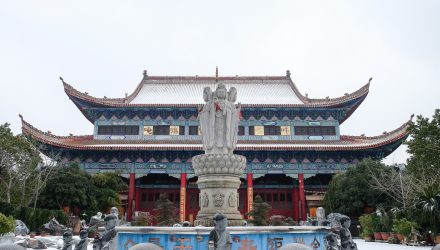Traditional emerging markets indexes, such as the MSCI Emerging Markets Index, are cap-weighted, meaning the largest companies in these indexes command the largest weights and so on. Cap-weighted emerging markets indexes also expose investors to some geographic concentration risk, mainly by way of China.
For example, the Vanguard FTSE Emerging Markets ETF (NYSEArca: VWO), which tracks the FTSE Emerging Markets All Cap China A Inclusion Index, the iShares Core MSCI Emerging Markets ETF (NYSEArca: IEMG) and the iShares MSCI Emerging Markets ETF (NYSEArca: EEM) each allocate approximately a third of their respective weights to Chinese stocks.
Smart beta alternatives, such as the Schwab Fundamental Emerging Markets Large Company ETF (NYSEARCA: FNDE), can help investors reduce China exposure.
FNDE tracks the Russell Fundamental Emerging Markets large Company Index, which selects, ranks and weights components based on fundamental factors like adjusted sales, retained operating cash flow and dividends plus buybacks.
Use FNDE to Reduce China Exposure
It is unlikely that cap-weighted emerging markets benchmarks will reduce China exposure anytime soon.
“For the foreseeable future, it is likely that most broad, market-cap-weighted emerging-markets indexes will have sizable allocations to Chinese stocks,” said Morningstar in a recent note. “Just how much Chinese stocks’ representation in these benchmarks expands (or, potentially contracts) depends on the future growth of the Chinese market and the degree to which China A-shares are included in these funds’ bogies. Both have been moving in a direction that suggests emerging-markets stock indexes will continue to increase their concentration in China.”
